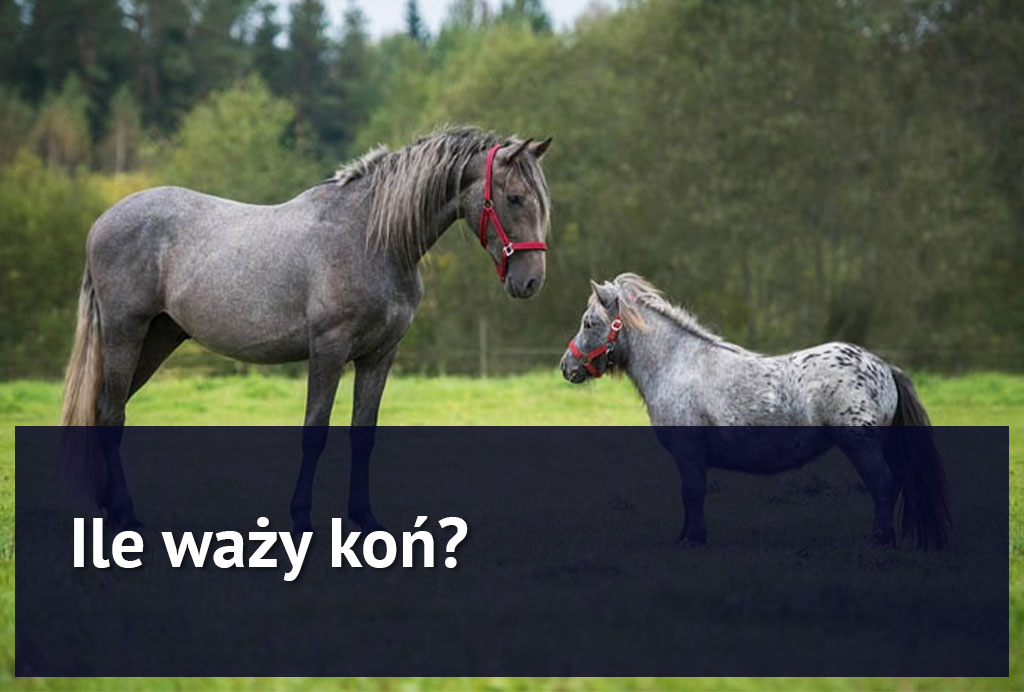
Waga koni zależy od wielu różnych czynników. Jest ona jednym z cennych wskaźników oceny zdrowia zwierzęcia. Ocena przybliżonej masy konia jest możliwa, dzięki specjalnym technikom i narzędziom. Koniecznie dowiedz się, dlaczego znajomość wagi konia jest istotna, od czego ona zależy i jak można ją sprawdzić!
Dlaczego sprawdzanie wagi konia jest ważne?
Regularne kontrolowanie wagi konia jest bardzo ważne, aby móc określić bieżący stan zdrowia i kondycję zwierzęcia. Wszelkie odchylenia od normy są dla nas cenną informacją sugerującą konieczność kontroli weterynaryjnej konia oraz przeanalizowania jego obecnej diety i warunków utrzymania. Warto również mieć świadomość tego, że nadwaga, jak i niedowaga mogą skutkować poważnymi problemami zdrowotnymi. Kontrolowanie prawidłowej masy ciała konia jest bardzo istotne dla jego zdrowia, a także pozwala odpowiednio dopasować jego dietę i zakres wysiłku odpowiadający możliwościom zwierzęcia.
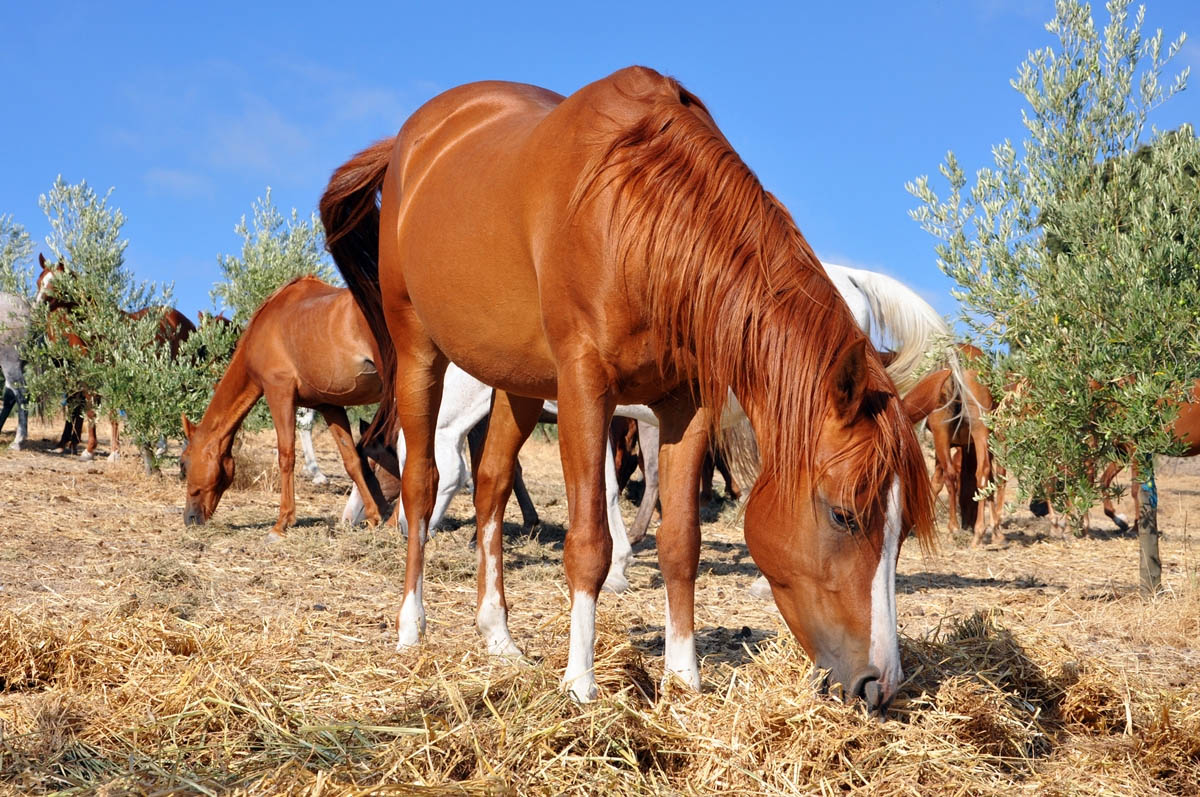
Ile waży źrebak po urodzeniu?
Szacuje się, iż waga nowonarodzonego źrebaka zwykle stanowi 10% masy ciała jego matki. Warto wiedzieć, iż jest ona zależna przede wszystkim od klaczy, a wpływ wagi ojca ma małe znaczenie. Czyli, jeżeli zdrowa matka waży 500 kilogramów to jej źrebię podczas narodzin będzie miało wagę około 50 kilogramów. Wyjątkiem są klacze, które są zaźrebiane po raz pierwszy, gdyż w takim przypadku niemal zawsze źrebięta rodzą się mniejsze niż zazwyczaj. Wagę poniżej średniej mają również źrebaki z ciąży bliźniaczej, wcześniaki oraz źrebięta przy których porodzie wystąpiły problemy porodowe.
Ile waży dorosły koń?
Odpowiedź na pytanie "Ile waży dorosły koń?" nie jest prosta. Jego waga zależna jest od wielu czynników, takich jak: wiek, rasa czy ogólny stan zdrowia. Szacuje się, iż dorosły koń mierzący od 160 do 170 cm może ważyć od około 500 do 600 kg. Konie zimnokrwiste mogą osiągnąć wagę liczącą ponad 800 kg. W przypadku kucy średnią wagę określa się jako 350 - 450 kg. To ile waży koń może się różnić pomiędzy poszczególnymi osobnikami chociażby ze względu na indywidualny sposób chowu, czy intensywność treningu. Koń, który większość czasu przebywa na pastwisku, będący w lekkim treningu, będzie ważył więcej niż koń tej samej rasy, będący w intensywnym treningu i posiadający rozbudowaną tkankę mięśniową.
Waga konia w zależności od typu
Waga konia jest zależna od typu rasy do którego on należy. Poglądowo możemy wyróżnić podział prezentujący się następująco:
Konie miniaturowe: 40 - 90 kilogramów
Kuce: 130 - 350 kilogramów
Konie lżejszych ras (tj. pełnej krwi): 400 - 700 kilogramów
Większe rasy pociągowe: 800 - 1000 kilogramów
Waga konia w zależności od rasy
Masę konia możemy wstępnie określić również na podstawie jego rasy:
| Rasa konia | Średnia waga ciała |
|---|
| Perszeron | 850.5 - 950 kg |
| Koń belgijski | 816.5 - 998 kg |
| Suffolk Punch | 751 - 900 kg |
| Shire | 701 - 1,200 kg |
| Koń ardeński | 701 - 1,000 kg |
| Clydesdale | 701 - 800.5 kg |
| Irish Draught | 599 - 800.5 kg |
| Tinker | 590 - 726 kg |
| Heavyweight Hunter | 590 - 698.5 kg |
| Cleveland Bay | 549 - 701 kg |
| Koń hanowerski | 549 - 651 kg |
| American Warmblood | 549 - 599 kg |
| Dutch Warmblood | 549 - 599 kg |
| Koń oldenburski | 544 - 680.5 kg |
| Koń fryzyjski | 544 - 635 kg |
| Duński koń gorącokrwisty | 544 - 635 kg |
| Koń andaluzyjski | 544 - 590 kg |
| Paso Fino | 544 - 590 kg |
| Koń trakeński | 499 - 680.5 kg |
| Middleweight Ridden Hunter | 499 - 635 kg |
| Koń wielkopolski | 499 - 635 kg |
| Highland Pony | 499 - 599 kg |
| American Saddlebred | 453.5 - 544.5 kg |
| Koń holsztyński | 449 - 800.5 kg |
| Koń westfalski | 449 - 599 kg |
| Lightweight Ridden Hunter | 449 - 590 kg |
| Thoroughbred | 449 - 499 kg |
| Paint | 431 - 544.5 kg |
| American Quarter | 431 - 544 kg |
| Hackney Horse | 410.5 - 544 kg |
| Koń lipicański | 410.5 - 544 kg |
| Nakota | 408 - 680 kg |
| Missouri Fox Trotter | 408 - 544 kg |
| Tennessee Walker | 408 - 544 kg |
| Koń luztytański | 408 - 499 kg |
| Morgan | 408 - 499 kg |
| Polo Pony | 408 - 499 kg |
| Morgan | 408 - 499 kg |
| Szwedzki koń gorącokrwisty | 399 - 549 kg |
| Hackney | 399 - 549 kg |
| Dales Pony | 399 - 499 kg |
| Fiord | 399 - 499 kg |
| Koń czystej krwi arabskiej | 360.5 - 449 kg |
| Haflinger | 349 - 599 kg |
| Kuc Fell | 349 - 449 kg |
| Welara | 299 - 399 kg |
| Kuc Eriskay | 299 - 399 kg |
| Kuc Exmoor | 299 - 399 kg |
| Kuc Connemara | 290 - 390 kg |
| Kuc Hackney | 249.5 - 349 kg |
| Kuc New Forest | 231 - 331 kg |
| Kuc Spotted | 199.5 - 399 kg |
| Kuc Dartmoor | 199.5 - 320 kg |
| Kuc szetlandzki | 181.5 - 199.5 kg |
Waga konia a wzrost w kłębie
To ile waży koń możemy orientacyjnie przewidzieć na podstawie pewnego przyjętego schematu. Należy jednak wziąć pod uwagę, iż są to dane bardzo ogólne i mają one na celu tylko przybliżyć nam obrazowo prawdopodobną masę zwierzęcia bazując na jego wzroście.
| Wzrost w kłębie | Waga |
|---|
| 91 cm | 190 do 240 kg |
| 101 cm | 240 do 280 kg |
| 111 cm | 240 do 318 kg |
| 121 cm | 240 do 370 kg |
| 131 cm | 280 do 399 kg |
| 141 cm | 360 do 449 kg |
| 151 cm | 399 do 550 kg |
| 161 cm | 469 do 701 kg |
| 171 cm | 551 do 800 kg |
| 181 cm | 700 do 1040 kg |
Waga konia a długość ciała i obwód
Przybliżoną wagę konia można obliczyć wykorzystując do tego obwód obszaru od kłębu do miejsca popręgu oraz długość ciała konia. Wzór w zależności od wieku i typu konia wygląda następująco:
Waga dorosłego dużego konia: (obwód x obwód x długość ciała) / 330 = masa ciała w funtach
Waga rocznego konia: (obwód x obwód x długość ciała) / 301 = masa ciała w funtach
Waga odsadka: (obwód x obwód x długość ciała) / 280 = masa ciała w funtach
Waga kucyka: (obwód x obwód x długość ciała) / 299 = masa ciała w funtach
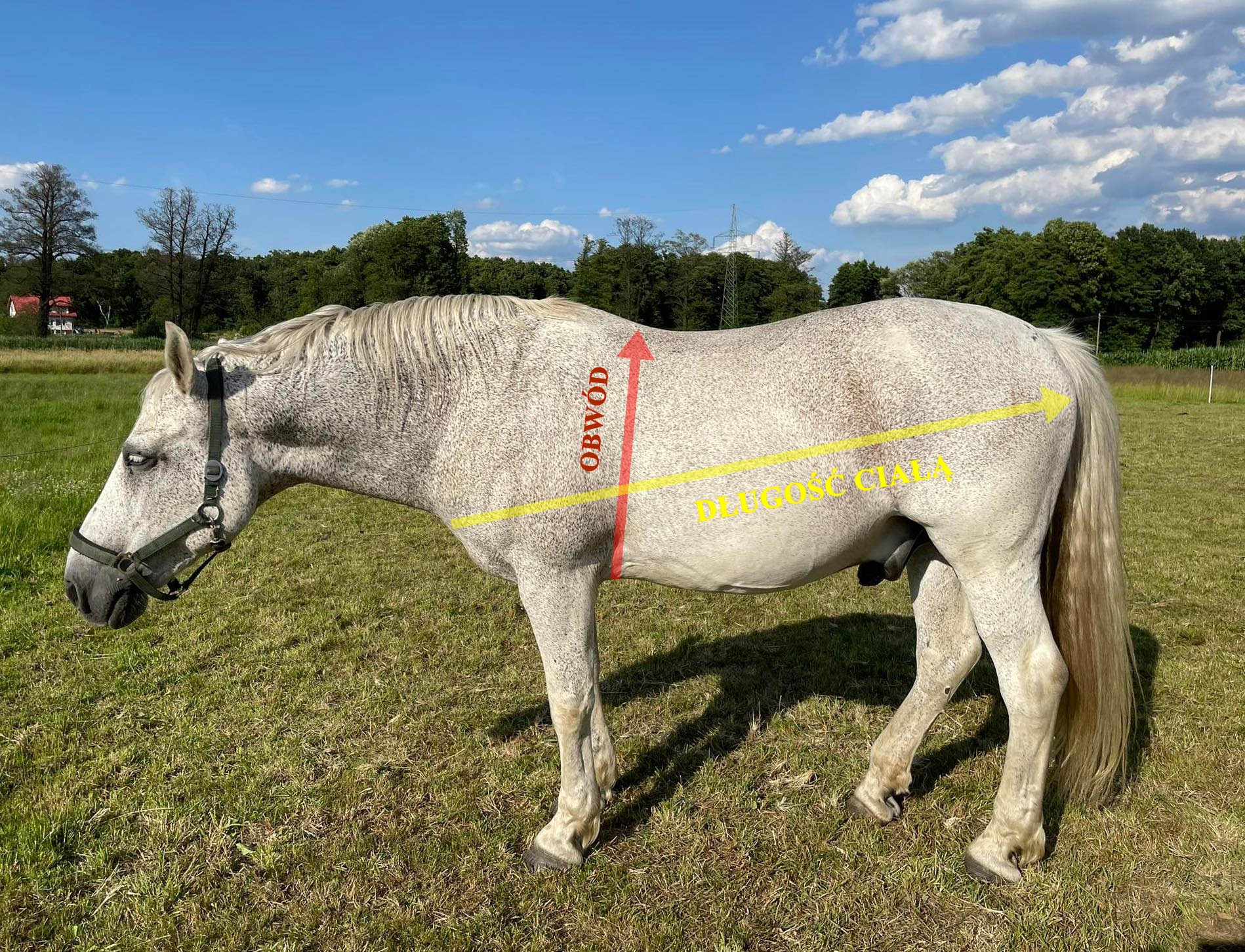
Wiek a waga konia
Średnia waga konia może być również przewidywana na podstawie wieku. Przyjmuje się, iż nowonarodzone źrebięta powinny ważyć około 10% masy ciała matki. W przypadku odsadków szacuje się, iż przybierają one 0,9 do 1,1 kg na dzień. Roczne źrebięta powinny ważyć około 50 % wagi dorosłego osobnika. Konie dwuletnie zazwyczaj ważą około 90% wagi dorosłego konia, a ostateczną wagę osiągają w wieku 4 lat.
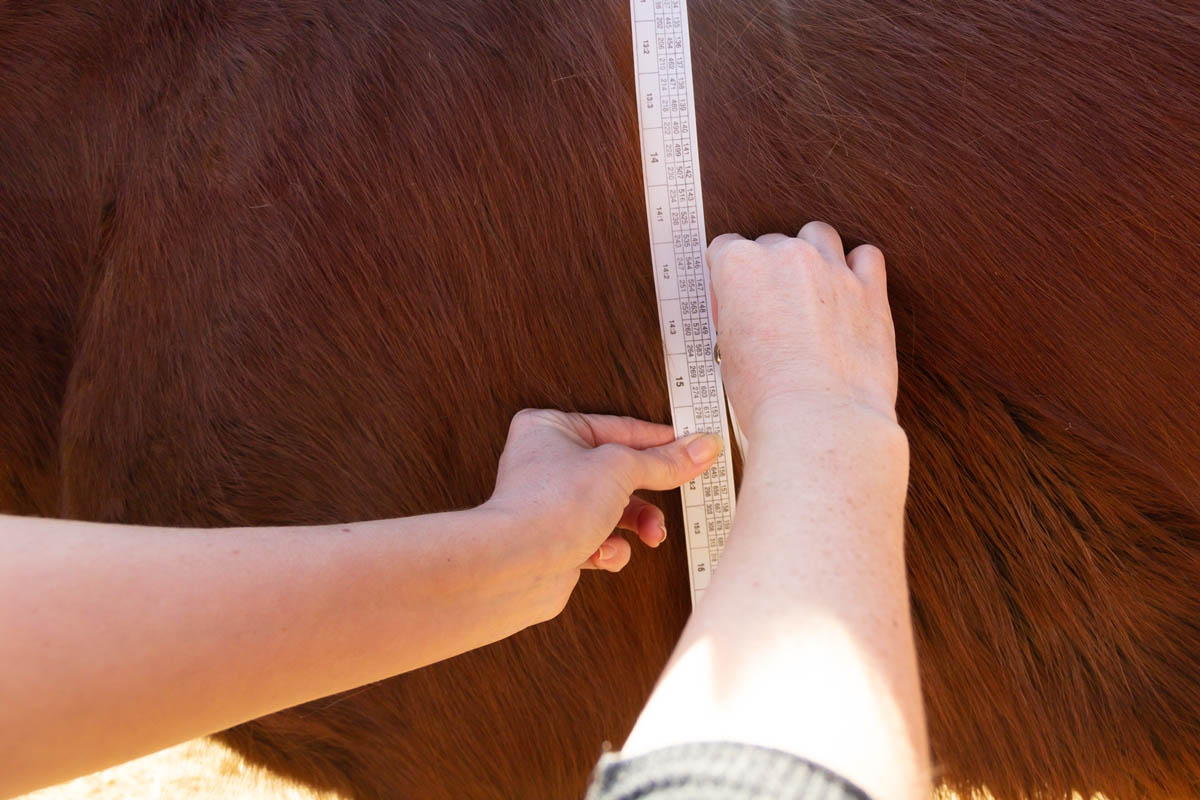
Jak określić wagę konia?
Poznanie przybliżonej masy konia jest możliwe, dzięki specjalnej miarce lub wzorom obliczeniowym. Należy jednak pamiętać, iż uzyskane wyniki mają wartość przede wszystkim orientacyjną.
Taśma do mierzenia
Na rynku jeździeckim dostępna jest specjalna taśma wagowa, która umożliwia sprawdzenie rozmiaru, obwodu i przybliżonej wagi konia. Według instrukcji należy zmierzyć obwód brzucha zwierzęcia na długości między przednimi nogami i kłębem. W rezultacie otrzymujemy wymiary obwodu klatki piersiowej, wagę konia w kilogramach, a także jego wzrost.
Wzór Sasimowskiego i Budzyńskiego
Przybliżoną wagę konia możemy obliczyć na podstawie specjalnego wzoru Sasimowskiego i Budzyńskiego. Najpierw należy zmierzyć obwód tułowia, przez miejsce stawu barkowego i kości kulszowej konia. Następnie mierzymy obwód kłody za kłębem i łokciem konia. Ostatecznie należy podstawić uzyskane wartości do wzoru: podłużny obwód tułowia (cm) x obwód kłody (cm) x współczynnik rasy.
Wzór można przedstawić również w postaci: C = O x P x W. Gdzie O oznacza obwód klatki piersiowej, P to podłużny obwód tułowia mierzony od zewnętrznych obszarów stawów barkowych i guzy kulszowe. Obydwa z wyników należy podać z dokładnością do 0,01. Ostatnia ze zmiennych - W, oznacza właściwy współczynnik wagi konia, który obliczamy wzorem W = C / O x P.
Współczynnik rasy:
Konie małopolskie = 75
Konie wielkopolskie = 75
Fiordingi = 72
Konie śląskie = 81
Ardeny = 81
Konie sztumskie = 82
Konie śląskie = 81
Konie pełnej krwi angielskiej = 70
Konie czystej krwi arabskiej = 60
Kuce = 60-63
Średnia współczynników ras = 75
W przypadku koni, które nie zaliczają się do żadnej z powyższej grupy rasowej należy do wzoru podstawić średnią współczynników ras.
Metoda Carolla i Huntingtona
Ten wzór obliczeniowy jest uznawany za nieco dokładniejszy. Pomiary należy zacząć od zmierzenia obwodu kłody, a następnie mierzymy długość konia w odcinku od kości kulszowej do stawu barkowego. Uzyskane pomiary podstawiamy do wzoru: [obwód kłody (cm)2 x długość (cm)]: 11877.
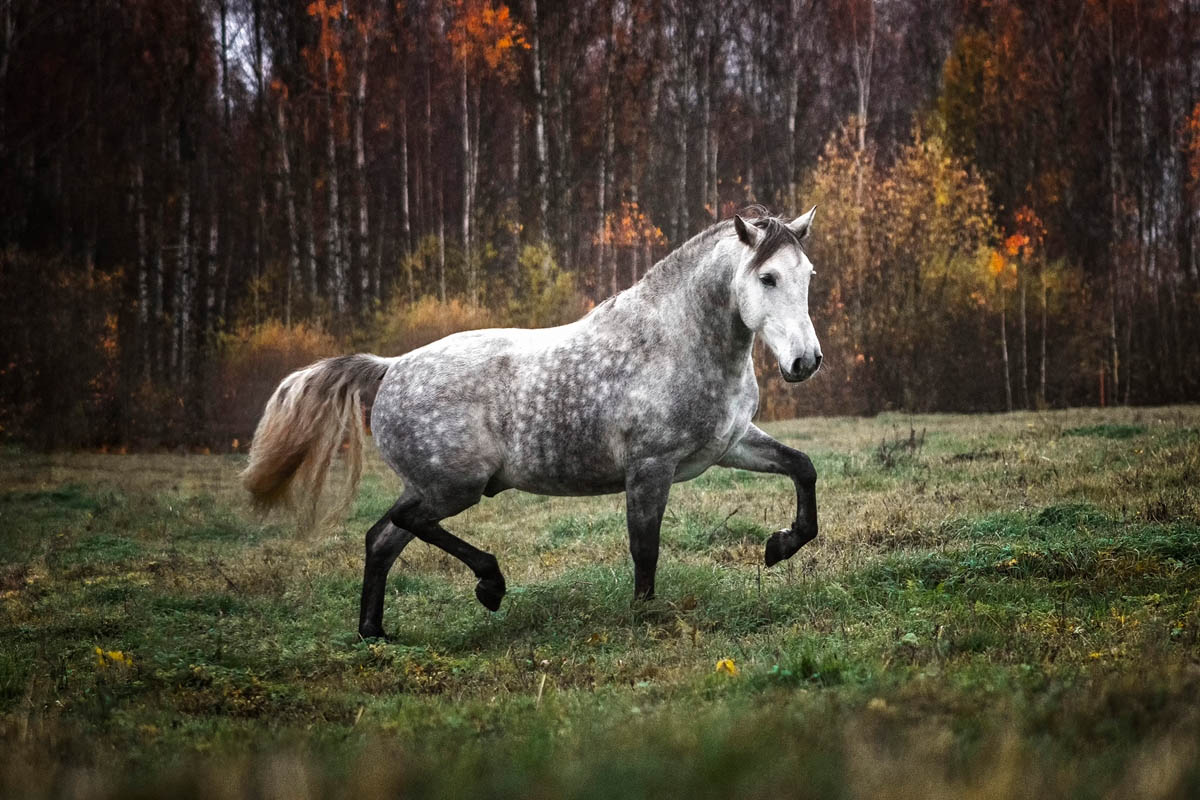
Ocena stanu ciała konia metodą BCS
Metoda Body Condition Scoring (BCS) została opracowana przez Dr Dona Henneke ponad 40 lat temu. Ma ona na celu ocenę kondycji ciała konia z wykorzystaniem wrażeń wzrokowych oraz dotykowych. Ocena zawiera się na skali od 1 - 9, gdzie najniższy wynik oznacza stan ekstremalnego wychudzenia, a najwyższy ekstremalną otyłość. Pożądanymi wynikami oznaczającymi prawidłową kondycję są pozycje od 4 do 6. Należy pamiętać, iż BCS jest metodą skupiającą się na obiektywnej ocenie teraźniejszego stanu konia. Zawsze należy wziąć po uwagę indywidualne cechy zwierzęcia, gdyż na jego stan ma wpływ wiele innych czynników. Oceniając kondycję ciała konia skupiamy się na 5 konkretnych jego partiach:
Szyja i kłąb
- 1 – Brak widocznego tłuszczu. Szyja jest wiotka u podstawy, a kłąb wystający z widoczną strukturą kostną.
- 2 – Grzebień szyi jest zapadnięty i wyraźnie zarysowany. Kłąb kościsty.
- 3 – Grzebień szyi jest zapadnięty, bez równego połączenia z resztą ciała. Wyczuwalna jest cienka warstwa tkanki tłuszczowej wzdłuż grzebienia i otaczająca kłąb.
- 4 – Szyja jest płynnie połączona z resztą ciała oraz widoczna jest warstwa tłuszczu na jej szczycie.
- 5 – Prawidłowo prezentująca się szyja wraz z właściwą ilością warstwy tłuszczu. Grzebień szyi scala ją i zaokrągla z łukiem kłębu.
- 6 – Wyczuwalna jest tkanka tłuszczowa na szyi i po obu stronach kłębu.
- 7 – Obserwuje się wyraźną warstwę tłuszczu na grzebieniu szyi oraz słabo zarysowany kłąb.
- 8 – Szyja jest wyraźnie pogrubiona i daje wrażenie oddzielenia tłuszczu od niej samej.
- 9 – Szyja jest obficie otłuszczona. Tkanka tłuszczowa może zwieszać się na jedną stronę szyi. Na kłębie widoczne są wypukłe depozyty tkanki tłuszczowej.
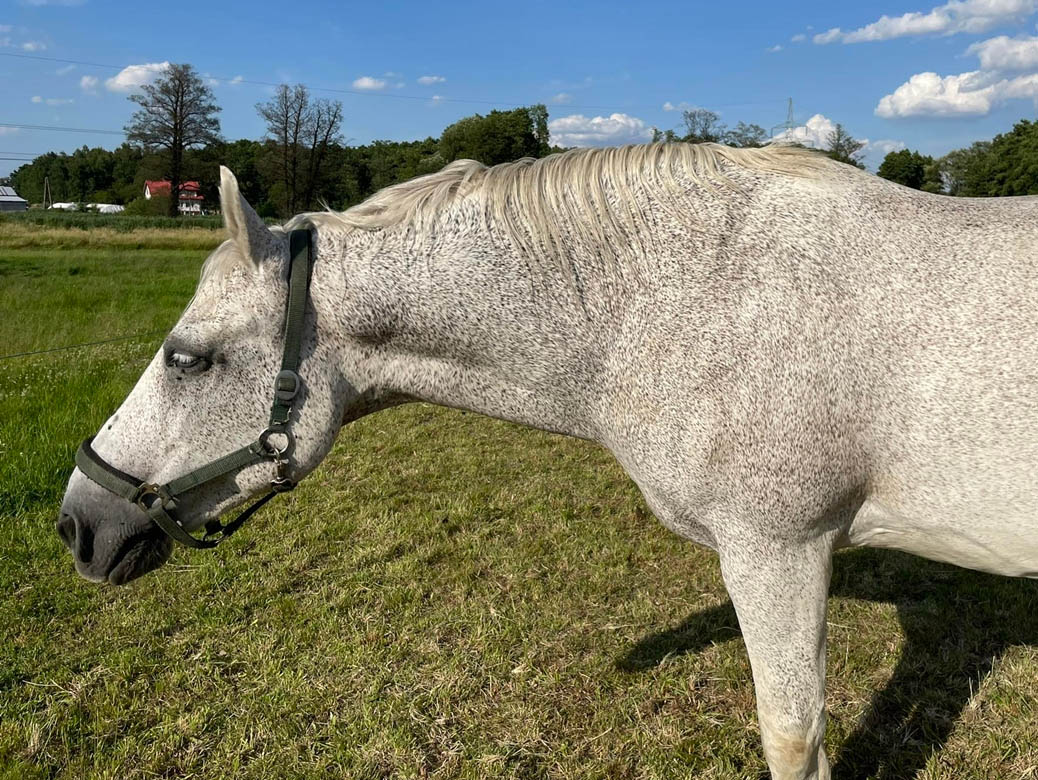
Łopatka
- 1 - Kości łopatki są wyraźnie odstające.
- 2 – Łopatka jest widoczna, lecz tkanka tłuszczowa niewyczuwalna.
- 3 – Zarys łopatki jest lekko widoczny.
- 4 – Łopatka słabo widoczna.
- 5 – Łopatka jest równomiernie pokryta tkanką mięśniową, a tłuszcz lekko wyczuwalny.
- 6 – Obserwuje się lekko widoczne i wyczuwalne w dotyku depozyty tkanki tłuszczowej na łopatce.
- 7 – Tkanka tłuszczowa na łopatce i jej okolicach jest wyraźnie wyczuwalna.
- 8 – Obszar łopatki jest wyraźnie wypełniony tłuszczem.
- 9 – Obserwuje się wyraźne depozyty tłuszczowe.
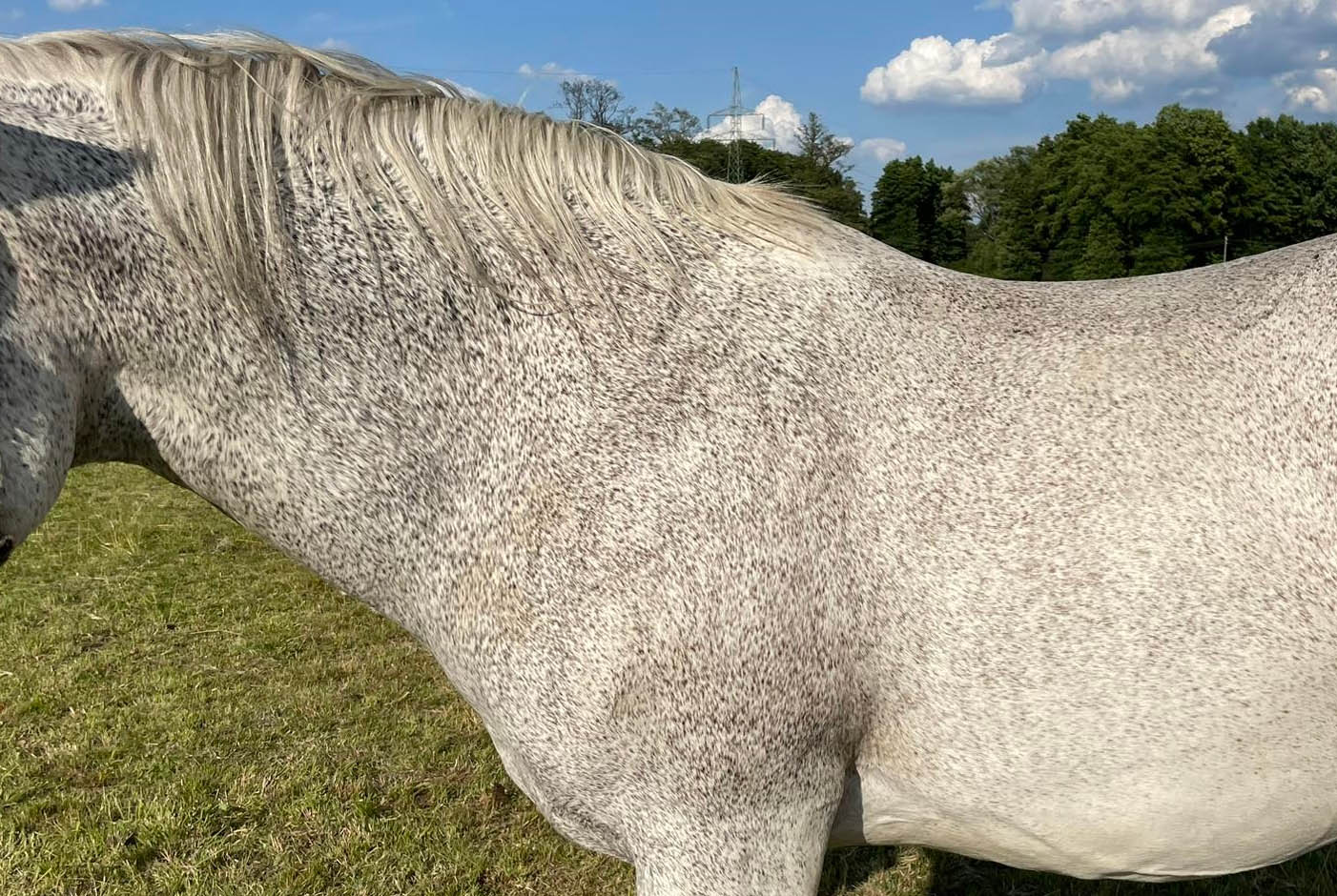
Żebra
- 1 – Wystające i wyraźnie widoczne żebra. Obserwuje się brak jakiejkolwiek tkanki tłuszczowej.
- 2 – Wystające żebra, które są pokryte nieznaczną warstwą tkanki tłuszczowej.
- 3 – Wystające i łatwo wyczuwalne żebra, które są pokryte lekką warstwą tłuszczu.
- 4 – Żebra są lekko widoczne.
- 5 – Żebra są niewidoczne, lecz łatwo wyczuwalne w dotyku.
- 6 – Żebra są otoczone tkanką tłuszczową, a ich wyczucie wymaga głębszego dotyku.
- 7 – Żebra są trudne do wyczucia pod tkanką tłuszczową.
- 8 – Żebra niemalże całkowicie niewyczuwalne pod warstwą tłuszczu.
- 9 – Żebra konia są wyraźnie wypełnione tkanką tłuszczową.
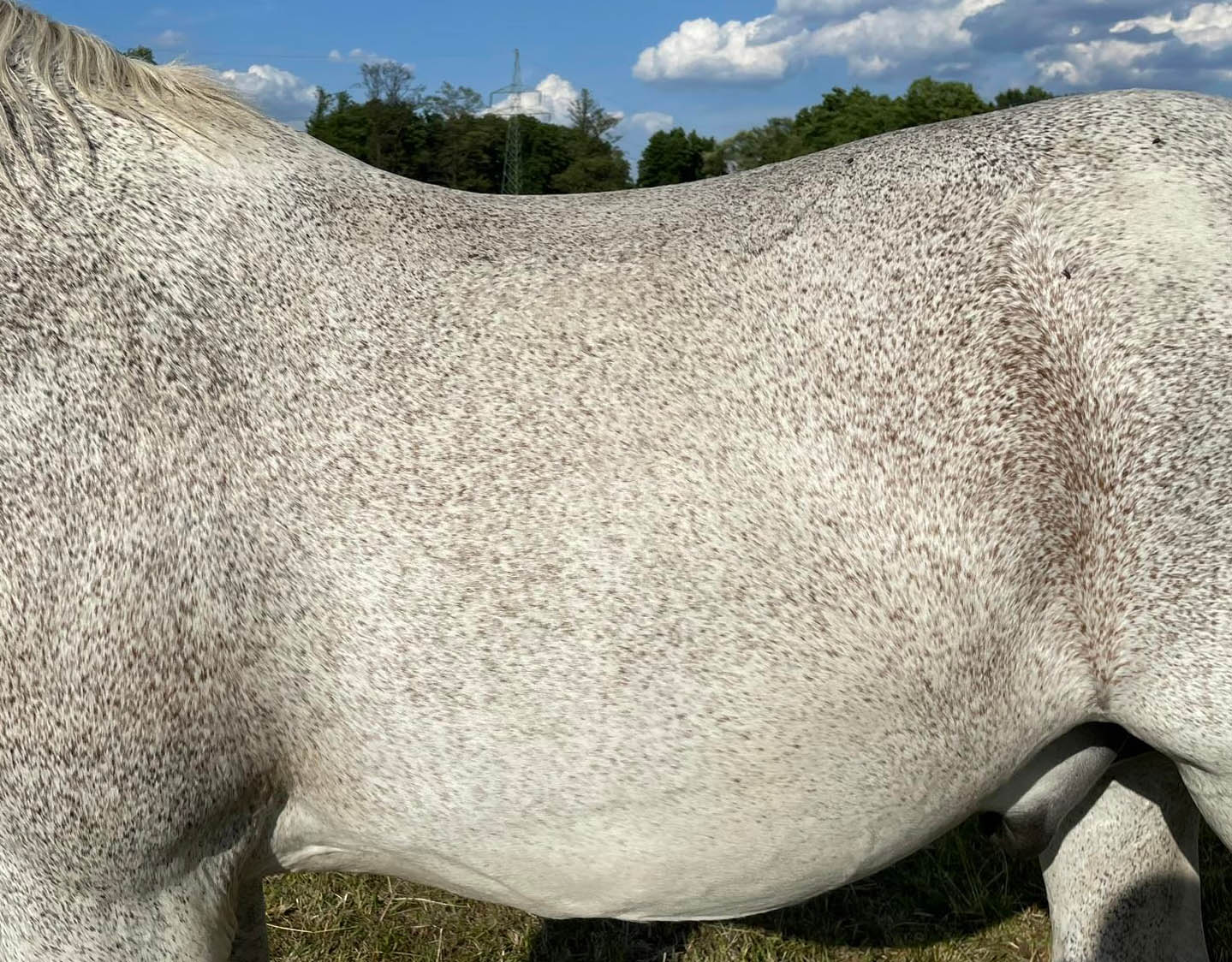
Grzbiet
- 1 – Linia grzbietowa jest mocno zarysowana, a struktura kręgosłupa i kręgów wyraźnie zauważalna.
- 2 – Kręgosłup jest wyraźnie wystający oraz obserwuje się znikomą warstwę tłuszczu na wyrostkach kolczystych.
- 3 – Widoczne jest słabe nagromadzenie tłuszczu, a struktura kręgosłupa jest słabo widoczna.
- 4 – Obserwuje się nieznacznie nabudowany grzbiet.
- 5 – Grzbiet jest odpowiednio podniesiony z umiarkowaną ilością tłuszczu. Wyrostki są wyczuwalne, lecz nie wystające.
- 6 – Wyrostki kolczyste kręgosłupa są nieznacznie wyczuwalne, a linia grzbietu bardziej miękka w dotyku.
- 7 – Wyrostki kolczyste kręgosłupa są słabo wyczuwalne, lecz w tylnej części grzbietu można wyczuć wyraźną warstwę tłuszczu.
- 8 – Wzdłuż kręgosłupa widoczny jest rowek utworzony z tkanki tłuszczowej. Szkielet kręgosłupa jest niewyczuwalny.
- 9 – Rowek wzdłuż grzbietu jest wyraźnie widoczny, obserwuje się tzw. “poduszki” wzdłuż grzbietu. Kościec jest niewyczuwalny.
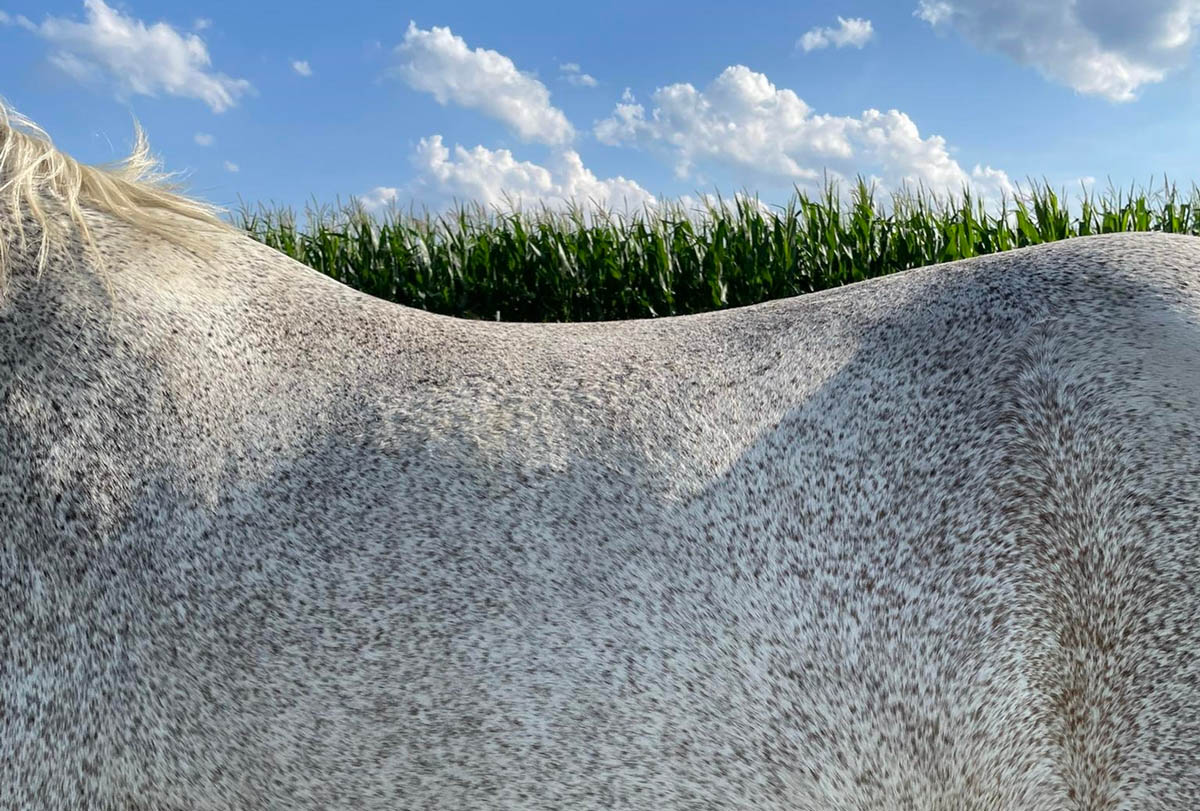
Zad i nasada ogona
Podczas oceny należy skupić się przede wszystkim na nasadzie ogona, ale należy również wziąć pod uwagę cały zad.
- 1 – Brak wyczuwalnej tkanki tłuszczowej, mięśnie w zaniku oraz wyraźnie wystające nasada ogona, guzy kulszowe i biodrowe.
- 2 – Mocno wystająca nasada ogona, guzy kulszowe i biodrowe są wystające oraz obserwuje się znikome zapasy tkanki tłuszczowej.
- 3 – Tkanka tłuszczowa wokół nasady ogona jest lekko wyczuwalna. Guzy biodrowe są niewidoczne.
- 4 – Wyczuwalna jest tkanka tłuszczowa wokół nasady i rzepu ogona. Guzy kulszowe są niewidoczne.
- 5 – Nasada ogona pokryta jest miękkim tłuszczem, a rzep ogona jest wyczuwalny.
- 6 – Miękki, widoczny oraz równo rozłożony tłuszcz wokół nasady ogona.
- 7 – Wyraźnie obserwowalny tłuszcz w okolicy nasady ogona.
- 8 – Rzep ogona jest gruby i otoczony znaczą ilością miękkiej tkanki tłuszczowej. Można zaobserwować "rozłupany" zad.
- 9 – Nasada ogona jest obficie wypełniona depozytami tkanki tłuszczowej. Rozłupany zad.
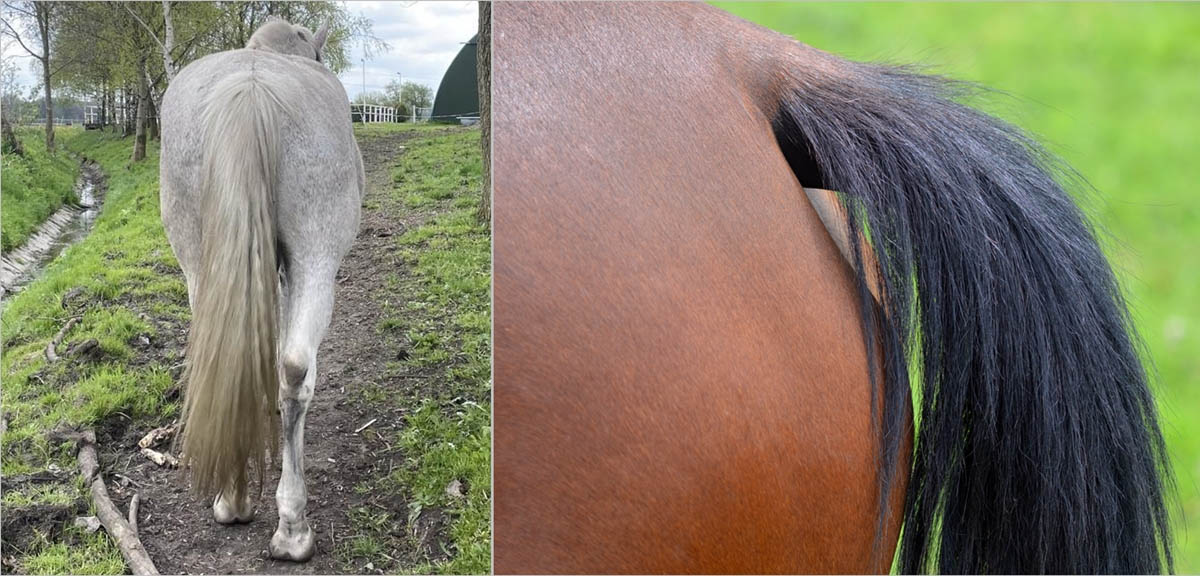
Waga konia a waga jeźdźca
Orientacyjnie przyjmuje się, iż idealna waga jeźdźca mieści się w przedziale od 10 do 15 % wagi konia. Czyli jeżeli koń waży 500 kg to najlepiej dopasowany do niego jeździec powinien ważyć od około 50 do 70 kg. W przypadku jeźdźców o większej wadze warto przemyśleć wybór wierzchowca o większej możliwości udźwigu. Dosiadanie konia przez zbyt ciężkiego jeźdźca może prowadzić do wielu przykrych konsekwencji. Zbyt duże obciążenie może doprowadzić do uszkodzenia kręgosłupa, stawów oraz mięśni, a także może spowodować zanik chęci do pracy i obniżenie jakości ruchu zwierzęcia. Należy również pamiętać, iż powyższe obliczenia powinny być traktowane jako wartości orientacyjne - nie zawsze waga konia jest czynnikiem decydującym o tym ile powinien on móc dźwigać na swoim grzbiecie.
Najlżejsze i najcięższe konie w historii
Rekord Guinnessa na najmniejszego żyjącego konia płci męskiej należy do konia o imieniu Bombel. Aktualnie zamieszkuję on Stadninę Koni Kaskada w Łodzi. Bombel waży 60 kilogramów, ma 56,7 centymetrów wzrostu, a jego rekord został oficjalnie zatwierdzony 24 kwietnia 2018 roku.
Koniem, który osiągnął największą wagę w historii jest Sampson - koń zimnokrwisty rasy Shire. Urodził się on w 1846 roku w Toddington w Anglii. Wazył 1500 kilogramów oraz mierzył ok. 230 centrymetrów w kłębie. Gdy osiągnął wiek 4 lat zmieniono jego imię na Mammoth (Mamut).
Podsumowanie
Waga konia zależy od wielu różnych czynników. Określenie jego dokładnej wagi jest niemalże niemożliwe, lecz istnieją pewne metody i narzędzia obliczające przybliżoną masę zwierzęcia. Przyjmuje się, iż źrebięta po urodzeniu osiągają około 10% masy matki. W przypadku koni dorosłych o wzroście około 160-170 cm w kłębie ich średnia waga wynosi od 500 do 600 kilogramów. Konie pociągowe potrafią ważyć nawet ponad 800 kilogramów, a za najcięższego w historii uważa się konia Sampsona rasy Shire. Regularna kontrola wagi naszego konia jest również bardzo ważna, gdyż umożliwia szybką reakcję w przypadku zauważenia wszelkich odchyleń od normy mogących świadczyć o problemach zdrowotnych.
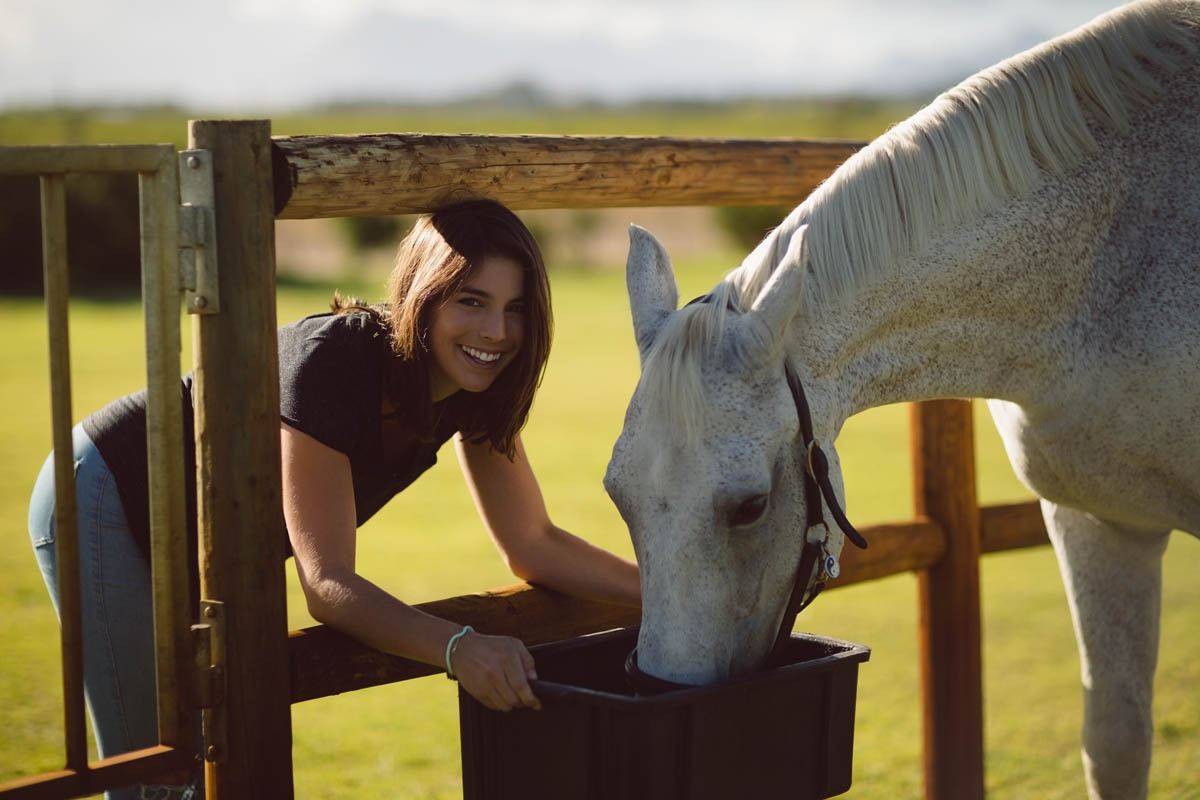
Zadbaj o prawidłową dietę swojego konia i odwiedź nasz dział: PASZA I SUPLEMENTY
Sklep jeździecki: +48 784 039 784
Dział siodeł: +48 606 914 300
E-mail: kontakt@equishop.com
Aktualności ze sklepu jeździeckiego Equishop:



















